How to Grow & Care for Aeoniums Plant
Written by Iris
Dec 15 2021
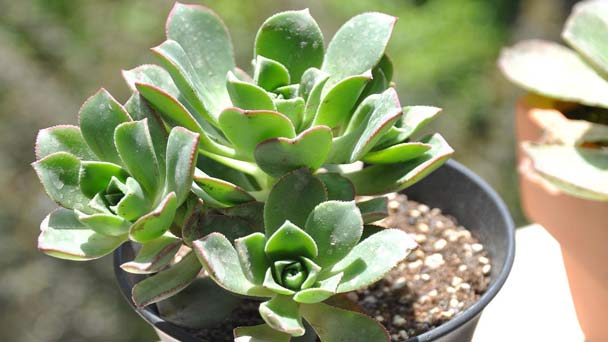
Aeonium is a succulent plant that grows in a compact rosette form similar to popular hens and chicks. Aeoniums come in a variety of colors, from bright green to moody black. Unlike many plants, the growing season of Aeoniums starts in winter and ends in spring.
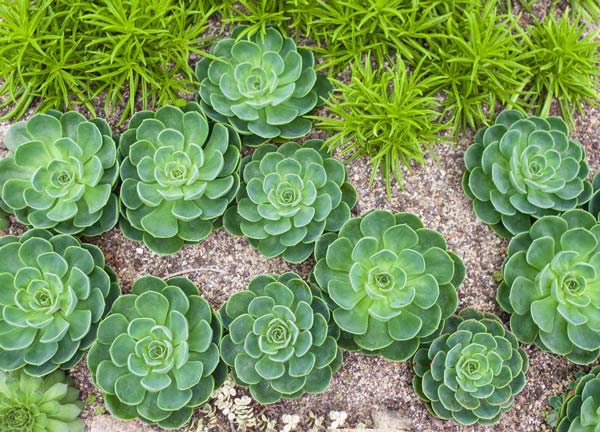
The selection of soil is entirely up to you. Keep in mind that Aeoniums growers often recommend filling up a pot with regular planting soil, and mixing it up with a cactus potting mix. Remember to use a well-draining clay pot.
Once the Aeoniums stem is all healed up, put it into the soil. It should stand straight. Place the pot somewhere warm and sunny, and water the succulent once a week. There is no need to go overboard, a small amount of water is enough.
Your new aeonium will be ready for replanting as soon as it develops a root system. Let the top layer of the soil dry before you start repotting the plant. Stop watering the succulent for a couple of days and check the ground with your finger. Then you can transfer your aeonium either into a bigger pot or to your garden.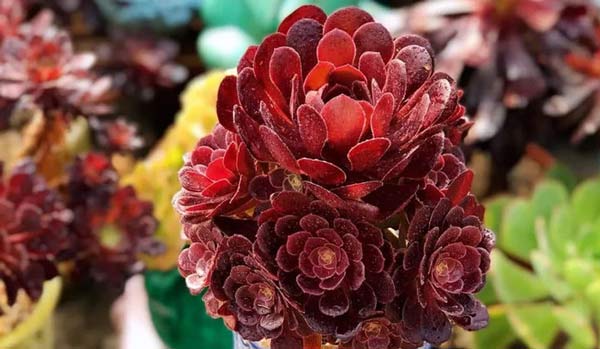
Aphids (Greenflies or Plant Lice)–These are small insects with fat, teardrop-shaped bodies. They can be found sucking on leaves or flowers at the end of the stems, on the leaves and the undersides of the plant.
Treat the plant with a mixture of soapy water. Add a few drops of dish soap in 1-2 cups of water and mix well. Spray onto infested areas and undersides of the leaves. You can also add vegetable oil to the soapy water. Put a few drops of dish soap in 1-2 cups of water with about 1 teaspoon of vegetable oil and mix well. Spray onto the infested areas where you see the bugs. Neem oil have also been used to treat and keep aphids away.
Mealybugs-Aeoniums are particularly susceptible to mealybugs. They are tiny and very easy to miss. An early sign your plants have mealybugs is the white cottony substance you see on your plants.
Use a cotton swab or Q-tip dipped in rubbing alcohol and apply directly on the bugs and anywhere you see the white cottony substance. Alternatively, you can use a spray bottle and spray rubbing alcohol directly onto the bugs and white fluff. Some people like to dilute the alcohol about half strength with water .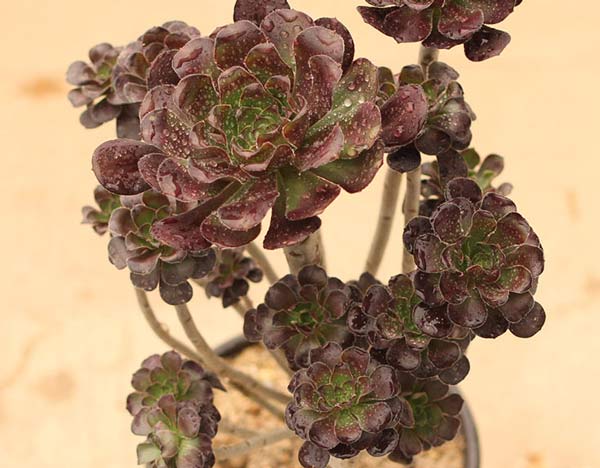
Aeonium arboreum 'Atropurpureum': This 3- to 5-foot tall cultivar has maroon leaves if grown in bright light.
Aeonium arboreum 'Zwartkop': This cultivar has very dark, almost black leaves. It, too, is a fairly large plant.
Aeonium 'Garnet': A hybrid cross of A. 'Zwarkop' and A. tabuliforme, this variety's leaves are green toward the middle and tipped with dark red.
Aeonium 'Sunburst': This variety is a shorter, 1- to 2-foot tall plant but has rosettes up to 1 foot across with pale yellow, white and green stripes, and pink tips.
Aeonium haworthii 'Tricolor' or 'Kiwi': An easy growing 2- to 3-foot plant, it has 4-inch flowers that have pale yellow centers when young, maturing to red and green.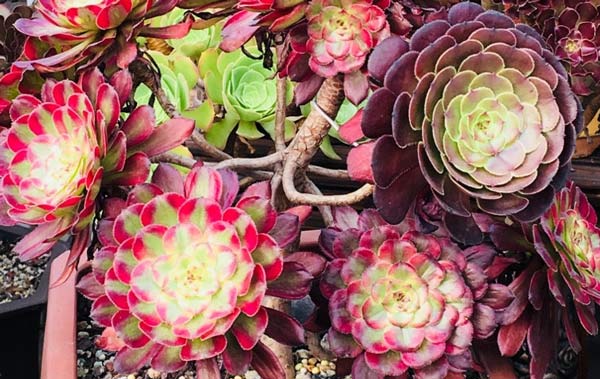
Where to Grow AeoniumsWhen to Grow AeoniumsHow to Grow AeoniumsAeoniums Propagation with Stem CuttingsHow to Care for AeoniumsAeoniums Light RequirementsSoil for AeoniumsAeoniums WateringAeoniums Temperature & Humidity CareFertilizer for AeoniumsPruning AeoniumsAeoniums Pests & Diseases CareVarieties of AeoniumsAeoniums Care FAQAre Aeoniums Hard To Grow?How Big Do Aeoniums Grow?When And How Long Do Aeoniums Bloom?
Where to Grow Aeoniums
Aeonium is not cold hardy, so if you live in a zone that gets colder than 30° F (-1.1° C), it's best to plantAeoniums in a container that can be brought indoors. aeoniums shows off its deep color in full sun. Plant Aeoniums in an area of your garden that gets 6 hours of sunlight a day.When to Grow Aeoniums
Aeoniums are widely recognized as winter-to-spring growers, which means Aeoniums go to sleep (go dormant) during the summer months. From experience however, aeoniums can be all-season growers, too. It is less about the time of year and more about the conditions Aeoniums live in. Specifically, temperature and sun exposure have greater impact on Aeoniums' behavior than the date on the calendar.
How to Grow Aeoniums
Aeoniums Propagation with Stem Cuttings
Succulents, in general, are easy to propagate, and aeoniums are no different. New Aeoniums often grow from dry leaves and stem pieces that fall to the ground. The quickest way to manually grow your aeonium garden is by cutting off the Aeoniums stems. Choose a Aeoniums stem that has a small rosette at the top and remove it carefully. Set it aside for three days, preferably away from the direct sunlight, and let the stem heal itself.The selection of soil is entirely up to you. Keep in mind that Aeoniums growers often recommend filling up a pot with regular planting soil, and mixing it up with a cactus potting mix. Remember to use a well-draining clay pot.
Once the Aeoniums stem is all healed up, put it into the soil. It should stand straight. Place the pot somewhere warm and sunny, and water the succulent once a week. There is no need to go overboard, a small amount of water is enough.
Your new aeonium will be ready for replanting as soon as it develops a root system. Let the top layer of the soil dry before you start repotting the plant. Stop watering the succulent for a couple of days and check the ground with your finger. Then you can transfer your aeonium either into a bigger pot or to your garden.

How to Care for Aeoniums
Aeoniums Light Requirements
As it's the case with most succulents, aeoniums too love being placed in an area with full sun exposure or with a bit of shade. Slight shade is recommendable in case you live in areas with very hot summers and dessert-like conditions. When you keep them indoors, make sure they get indirect, but bright light.Soil for Aeoniums
Many collectors report having better luck with a standard potting mix or sandy loam than with specially prepared cactus mix or succulent soil. A good, light potting mix will hold a slight amount of moisture around the roots without excessive sogginess.Aeoniums Watering
Watering Aeonium can be tricky even for the experienced gardener, as we're used to providing more water during the summer months. But since Aeoniums's growing season is different, it will actually need more water during the winter growing season. From winter until spring, water once the soil is completely dry. Water even more sparingly during the summer, especially when growing Aeonium outdoors in a hot climate.Aeoniums Temperature & Humidity Care
Aeoniums prefer a Mediterranean climate—not too hot, not too cold, not too dry. Most Aeonium varieties are only hardy in USDA Zones 9 to 11. Growing Aeoniums in moist shade will keep them growing in high heat, but Aeoniums' true growth season is winter to spring, when temperatures are cool (65 to 75 degrees Fahrenheit) and damp. Aeoniums may go dormant in summer and do not require excessive watering, except in excessively dry conditions. In extreme heat, their leaves will curl to prevent excessive water loss.Fertilizer for Aeoniums
Most aeoniums grow well without fertilizer and too much fertilizer can lead to weak, spindly growth and discoloration in otherwise healthy plants. The exception is for container-grown aeoniums, which can quickly exhaust their soil during the growing season. Usea slow release, 14-14-14 fertilizer that is specially formulated for cactuses and succulents. Apply it in spring after new growth emerges and again in midsummer. Use 1 teaspoon fore each 1 gallon of soil, and apply it evenly to moist soil.Pruning Aeoniums
During the growing season when the aeonium is about 15-20cm (6-8in) tall, you will need to remove some of the leaves and the growth bud at the very centre of the rosette to stimulate the plant to branch out. Gently peel up to 10 Aeoniums leaves away until you are left with a circular, bare patch about 1cm (½in) diameter in the centre. The original bare patch will form a scab. You will begin to notice little buds forming around the scab and as time goes on they will develop in to small rosettes. As they develop and become larger they will form new branches.Aeoniums Pests & Diseases Care
Aeoniums are not immune to common pests that bug succulents. Fortunately, they are resilient and hardy plants and can handle almost anything, even a bad infestation. Here are some common pests that can damage aeoniums:Aphids (Greenflies or Plant Lice)–These are small insects with fat, teardrop-shaped bodies. They can be found sucking on leaves or flowers at the end of the stems, on the leaves and the undersides of the plant.
Treat the plant with a mixture of soapy water. Add a few drops of dish soap in 1-2 cups of water and mix well. Spray onto infested areas and undersides of the leaves. You can also add vegetable oil to the soapy water. Put a few drops of dish soap in 1-2 cups of water with about 1 teaspoon of vegetable oil and mix well. Spray onto the infested areas where you see the bugs. Neem oil have also been used to treat and keep aphids away.
Mealybugs-Aeoniums are particularly susceptible to mealybugs. They are tiny and very easy to miss. An early sign your plants have mealybugs is the white cottony substance you see on your plants.
Use a cotton swab or Q-tip dipped in rubbing alcohol and apply directly on the bugs and anywhere you see the white cottony substance. Alternatively, you can use a spray bottle and spray rubbing alcohol directly onto the bugs and white fluff. Some people like to dilute the alcohol about half strength with water .

Varieties of Aeoniums
Aeonium arboreum: This widely available plant has bright green rosettes on a branching stem. It has a shrubby form and can grow as tall as 6 feet in the garden, or 3 feet in containers.Aeonium arboreum 'Atropurpureum': This 3- to 5-foot tall cultivar has maroon leaves if grown in bright light.
Aeonium arboreum 'Zwartkop': This cultivar has very dark, almost black leaves. It, too, is a fairly large plant.
Aeonium 'Garnet': A hybrid cross of A. 'Zwarkop' and A. tabuliforme, this variety's leaves are green toward the middle and tipped with dark red.
Aeonium 'Sunburst': This variety is a shorter, 1- to 2-foot tall plant but has rosettes up to 1 foot across with pale yellow, white and green stripes, and pink tips.
Aeonium haworthii 'Tricolor' or 'Kiwi': An easy growing 2- to 3-foot plant, it has 4-inch flowers that have pale yellow centers when young, maturing to red and green.

Aeoniums Care FAQ
Are Aeoniums Hard To Grow?
The Aeoniums plants readily available for cultivation tend to be easy-keepers. They branch freely and perform well even for beginning gardeners. They make an exciting addition to any collection because of the array of colors they display. Foliage transitions through shades of green, yellow, purple and red seasonally. Additionally, these plants may flower from time-to-time. Blossoms may be white, yellow, pink or red. The pretty, colorful flowers are attractive to bees and other pollinators. When one rosette finishes flowering, it dies, but surrounding rosettes live on. One cultivar (Aeonium simsii) does not die after flowering.How Big Do Aeoniums Grow?
There is tremendous variety in size among the members of this genus. Some types naturally grow only a few inches high with rosettes only one or two inches wide. Other types may grow to be three or four feet high with rosettes the size of a dinner plate. Size depends on a wide variety of factors.When And How Long Do Aeoniums Bloom?
Aeoniums start blooming late in the winter and may hold their blooms throughout the spring months.Latest Updated
- Benefits of Bugleweed - 7 Science-backed Health Benefits
- Bugleweed Dangers & Side Effects - Is It Poisonous?
- How to Plant Evergreen Trees - What You Should Know
- When to Plant Evergreens - Grow Guide for Evergreen Trees
- 12 Wonderful Evergreen Shrubs for Your Garden
- 12 Popular Evergreen Plants with Pictures for Beginners
- When And How To Prune A Lilac Bush Like a Pro
- How to Grow & Care for Lilac Vine (Hardenbergia Violacea)
- Japanese Lilac Tree (Syringa Reticulata) Care & Propagation Guide
- Shumard Oak Pros and Cons - What to Know
Popular Articles
- Winter maintenance of Antirrhinum Majus
- How to Grow Terminalia Mantaly Tree
- How to Grow and Care for Crossostephium Chinense
- How to grow Antirrhinum Majus in spring
- Peristeria Elata (Dove Orchid) Profile: Info & Care Guide
- Underwatered Snake Plant (Sansevieria Trifasciata) - Signs And How To Fix
- How to Care for Brazilian Jasmine Plant (Mandevilla Sanderi)
- How to Grow & Care for Graptopetalum Purple Delight in Summer
- Rosa Chinensis (China Rose): Plant Growing & Care Tips
- How to Care for Baby Sun Rose (Aptenia Cordifolia)